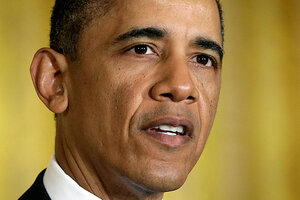Why President Obama's approval ratings are falling
The president's numbers are generally trending downward, polls show. A survey released Tuesday found 45 percent of Americans are happy with Obama's job performance, down from 50 percent in December. What gives?

President Obama speaks in the East Room of the White House in Washington, last week. Obama's approval rating is slipping downwards, polls show.
Pablo Martinez Monsivais/AP
Is President Obama’s approval rating slipping downwards amid the back and forth of "sequester" politics? That’s the conclusion of a just-released McClatchy-Marist poll. The survey finds that just 45 percent of voters are happy with Mr. Obama’s job performance, down from 50 percent in November and December. A plurality of 48 percent of respondents disapproves of the president’s actions, according to the McClatchy-Marist numbers.
Not all new polls are in agreement here. Tuesday’s Rasmussen tracking survey shows Obama’s approval rating above water at 52 percent, up one percentage point from last week.
But the medium-term trend for the president’s numbers is generally downward. The RealClearPolitics rolling average of Obama’s approval polls peaked at 53.8 percent on Christmas Day. Since then it’s steadily fallen to 48.8 percent, with 45.3 percent of respondents disapproving of the presidential performance.
What’s going on here? One thing pushing this sliding trend may be the quick end of the electoral honeymoon. The president’s reelection image machine has stopped churning, and the partisan glow his voters felt at his second-term victory is starting to fade.
Paradoxically, Obama may also be paying a price for attempting to appear as strong as possible in the recent series of D.C. fiscal crises.
“This may be the downside of him coming out of the box stronger in the second term,” Lee Miringoff, director of the Marist Institute for Public Opinion, told his McClatchy partners. “People are now looking for him to lead us out of this stalemate, provide more leadership. People see him as a strong figure and in the driver’s seat. During the election, it was him versus Romney. Now it’s him versus people’s expectations for the country.”
Then there’s the sequester itself. Gallup notes that its daily tracking poll showed the president’s approval rating dropping when the cuts took effect March 1. Since then, Obama’s Gallup numbers have bounced around day to day, but at the moment the firm has his approval rating at 49 percent, down from 53 percent in late February.
Obama’s “approval rating will likely remain in a precarious state until he and Congress can reach accord on federal spending and the budget deficit,” wrote Gallup’s Jeffrey Jones earlier this month.
Congress does not seem to be in a similar position. So far the sequester has had little effect on what Americans think about their legislature.
But in part that’s because it would be hard for opinion about Congress to sink any lower. In a March 11 Gallup survey, only 13 percent of respondents approved of Congress’s job performance. That’s just a few points higher than the all-time low of 10 percent hit last year.
“These low ratings could improve if Congress does something the public respects, but leave little room for a further drop if Americans continue to perceive Congress’ activities negatively,” writes Gallup editor in chief Frank Newport.

